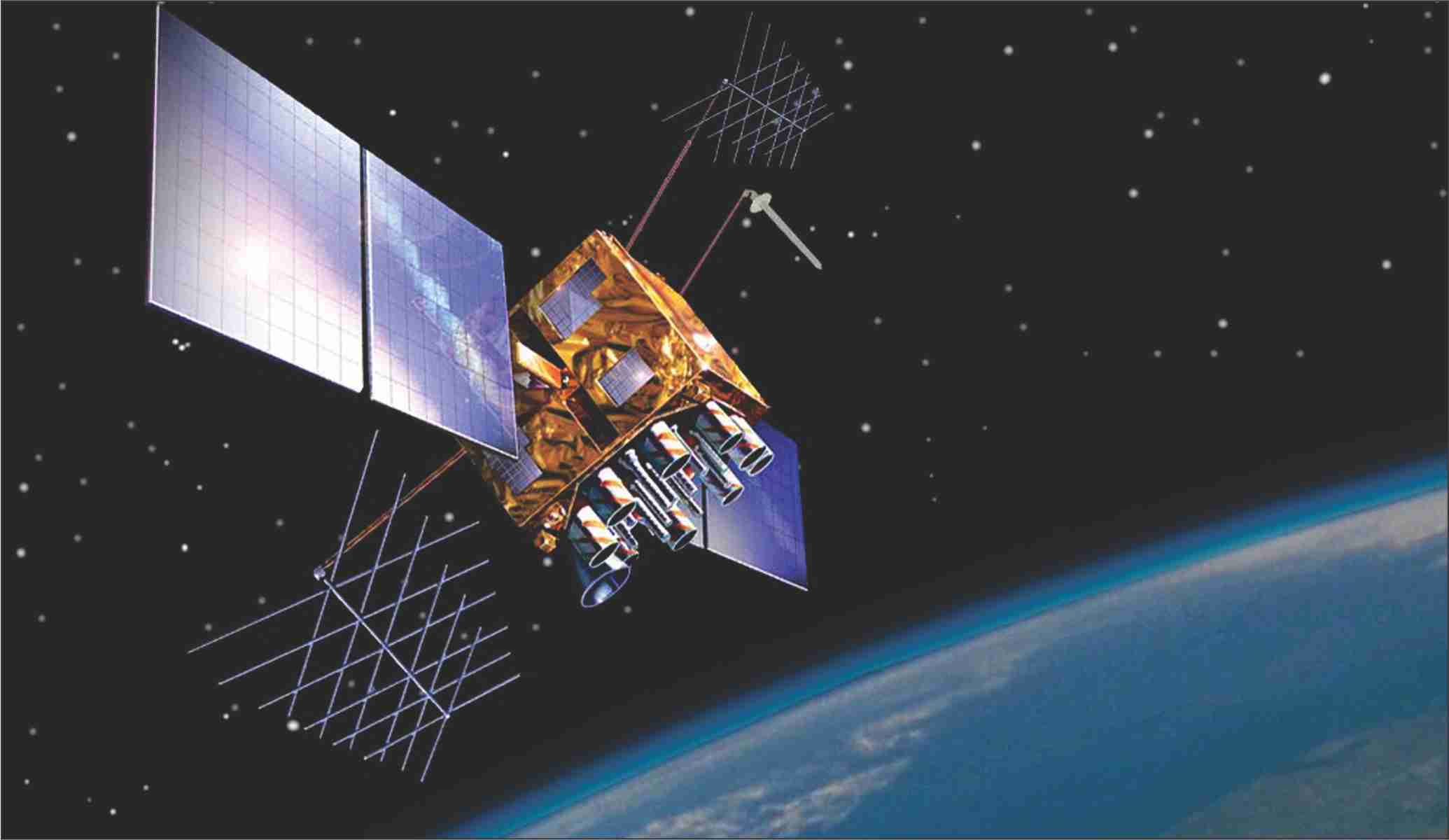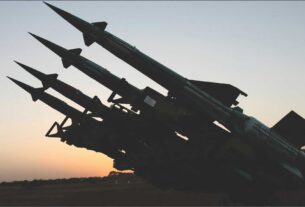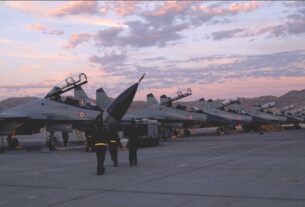The successful launch of India’s fourth navigation satellite, IRNSS-1D, by means of an augmented version of the Indian space workhorse, the four stage Polar Satellite Launch Vehicle (PSLV) in March this year, while bringing the country a step closer to realizing the full fledged seven spacecraft IRNSS (Indian Regional Navigation Satellite System) constellation has given a boost to the network centric capability of the Indian armed forces.
It was the difficulties that Indian armed forces experienced in accessing the restricted services of the US military controlled GPS satellite navigation system that nudged the country to go in for an independent satellite navigation system. As it is, Indian defence forces have learnt through the hard way that the uninterrupted access to a home grown GPS system alone can pave way for refining and expanding its network centric capability. Indeed, the dual use potentials of IRNSS would help the Indian defence forces launch its long range missiles and high precision weapons with a high degree of accuracy and providing a boost to the network centric warfare strategy.
Moreover, access to IRNSS would provide Indian defence force a veritable head start in identifying locations, facilitating reconnaissance missions and aid search and rescue operations. Meanwhile, Indian Space Research Organisation (ISRO) has hinted at the possibility of expanding the seven spacecraft IRNSS constellation in the future by taking into account the needs for satellite based navigation services.
Navigation capability
On another front, IRNSS constellation will hold the key to the successful operation of the proposed aerospace command that will ultimately boost the network centric capabilities of the Indian armed forces by a substantial extent. Significantly, the network battlefield capability of the tri service Indian aerospace command could be boosted to a large extent by an imaginative exploitation of satellite resources. The creation of India’s tri service aerospace command is yet to get the green signal from the ruling dispensation in New Delhi.
Everything going as planned, three more satellites in the IRNSS constellation-IRNSS-1E, IRNSS-1F and IRNSS-1G-will be in orbit by the first quarter of the next year to help the country realize an independent satellite navigation system. The IRNSS constellation has been designed to provide highly accurate position, velocity and time information services in real time and under all weather conditions. As it is, navigation satellites have today emerged as vital space platforms with immense potentials to support the network centric operations of all the three wings of the services.
A large, independent navigation capability that can be accessed anytime from anywhere holds the key to the success of network centric operations. The US led allied forces during their operations in both Afghanistan and Iraq relied heavily on satellite based navigation capability with hand held GPS portable devices to meet their strategic goals speedily and efficiently. Prior to that, the stunning effectiveness of the American GPS constellation was demonstrated during the “Desert Storm” operations of 1990-91 that was aimed at freeing Kuwait from the clutches of invading forces from the neighbouring Iraq.
As it is, network centric capability has now become an inseparable and indispensable part of the operational philosophy of defence forces around the world. Indeed, net centric warfare architecture has evolved as a critical part of the “winning edge” warfare strategy. Today advanced satellite systems designed for a variety of end uses are serving as “command posts” in outer space and in the process emerged as a crucial component of network centric warfare strategy. A successful network centric battlefield strategy hinges on the optimal utilisation of a string of satellites serving as “eyes” and “ears” in outer space.
The full potentials of network warfare strategy can be realised only through the use of the satellite resources. But then as things stand now, Indian defence forces have only limited access to the INSAT/GSAT constellation of communications satellites and IRS series of earth observation satellites being operated by ISRO. Of course, there is a well conceived plan to equip all the three wings of the services with a string of satellites meant for a variety of end uses. Only a dedicated constellation of satellites would give Indian defence forces a veritable head start in refining network centric warfare capability.
Satellites
Warfare strategists are fully well aware that satellites hold the key for a well co-ordinated and synchronised operations of a battlefield strategy by seamlessly integrating weapons systems, missiles, radars and sensor suits, UAVs, weaponised drones electronics and communications network, fighter jets, transport aircraft, logistics and support systems and defence forces spread across and around the world for sustaining strategic superiority at all levels of strategic operations. As it is, the glaring intelligence failure suffered by the Indian defence forces during the 1999 Kargil war with Pakistan had as its causative factor the failure of the Indian defence establishment to provide Indian armed forces sustained and uninterrupted access to the “satellite capabilities”.
In a development of significance, the Indian Navy, the youngest of the three services, has already under its command a dedicated communications spacecraft that would drive its quest to position itself as a blue water maritime force by boosting its network centric capability. The GSAT-7 advanced multi band communications designed, developed and built by ISRO was launched by means of an Ariane-5 vehicle of the European space transportation company, Arianespace as a dedicated Indian naval space platform in August 2013. The high performance GSAT-7 satellite which happens to be India’s first exclusive defence satellite has provided the Indian Navy a safe and secure communications capability to systematically network all of its offshore and onshore resources. With its 2000-miles nautical footprint over the Indian Ocean, GSAT-7 serves as a force multiplier for the Indian Navy to network all its warships, submarines, aircraft and UAVs along with its ground based asset.
GSAT-7 would also provide the Indian Navy the necessary level of capability for its smooth and seamless integration into the tri service aerospace command, the formation of which is key in tackling the multi directional and multi- dimensional security threat faced by India. The synergy achieved between combat platforms moving in the high seas of the world through the satellite communications capability could help bring about a radical shift in the operational strategy of the Indian Navy. Indeed, for more than a decade now, Indian Navy has been clamouring for an advanced space platform with a view to refine and strengthen its “sensor to shooter” loop which implies an ability to swiftly detect and tackle a threat.
Indian Navy would be in a position to get a digital tactical battlefield view of the dispersed fleet formations, aircraft locations and even submarines moving stealthily in the depths of the oceans. In the ultimate analysis, GSAT-7 marks a small step towards Indian Navy’s strategy of transforming itself into a satellite augmented, network centric three dimensional blue water maritime force.
At the end of the day, a satellite based network centric approach helps derive advantages in terms of the ability to stay ahead of the opponents and dictate the dynamics of the engagement. The IAF would be the next to get a dedicated satellite in the form of GSAt-7A slated for launch during 2015-16 time-frame.
From the perspective of the Indian Army, the Tactical Communications System (TCS) and the Battlefield Management system (BMS) have all the potentials to provide high level of combat communication and networking capability to address the emerging needs of the battlefield. Both these networks when fully operational would transform the contours of the combat communications in the tactical battlefield arena. As part of its plan to position itself as a network centric force, the Indian Army has adopted the philosophy of integrating various components of C4I2 together with a thrust on information warfare. By all means, the Tactical Command, Control, Communications and Intelligence System or TACC3I system constitutes the formidable backbone of the network warfare strategy of Indian Army. Indian Army has also projected a need for a variety of exclusive satellites to meet its operational requirements in an efficient manner.
Satellites can serve as critical components of a network centric warfare which relies on the smartness with which the information super highway and communications channels are exploited for real time coordination of the “strategic moves” of defence forces spread across and around the world on land as well as oceanic and air borne platforms. A satellite based network centric approach helps derive advantages in terms of the ability to say ahead of an opponent.
Implementing strategy
Beyond satellites and communications networks, the successful implementation of network centric strategy calls for a total transformation of the mental make up and psychological strength of the combatants. The efficient utilization of the various networks and intelligence gathering systems forming part of network centric warfare strategy calls for conceptual and organization changes at various levels of operational strategy.
Some of the conspicuous features of network centric warfare include information superiority, shared situational awareness, speed of command, self synchronization, fighting with dispersed forces, speedier access to a range of sensors, creating higher rates of change and compressed timeliness for operations. The operational efficiency of mission critical automated systems holds the key to the success of network centric strategy.
With reference to the network centric warfare philosophy, information stands out as the fundamental building block which provides the infrastructure for receiving, processing, transporting, storing and protecting information in a real time environment. The sensor based information is distributed rapidly across the military formations with linkages and computing power of the information grid. By all means air, sea, land, space and cyber force elements can be linked and operated as a single networked entity with a well focused operational objective.
Intelligent, autonomous and high performance UCAVs with secure communications link have emerged as the key component of the network centred warfare philosophy. Not surprisingly then these days most of the drones and aircraft come with in built capability for networking with other platforms while ensuring safe and secure transmissions. Transforming the data collected from a variety of points into an accurate, holistic picture of the digital battlefield space constitutes the vital part of network centric battlefield strategy.
In a networked war fighting environment, communications satellites provide a high level of capability to connect to platforms and user terminals which many a times on account of their the environmental and topographical factors could remain out of the reach of ground based infrastructure.
The Indian Air Force (IAF) as part of its plan to boost the communication links in a big way and facilitate network capability across the spectrum has launched 3G cellular network named AFCEL (Air Force Cellular).This has made IAF the first among the services to have commissioned its own captive 3G network. The IAF through AFCEL aims to bring all its units and stations under the overreaching umbrella of 3G connectivity. This integrated network has been conceptualised by IAF to automate and integrate the functions of the entire spectrum of air operations.
On the other hand, Air Force Net (AFNET), an advanced communications system commissioned by IAF is a fibre optic based network on which the Integrated Air Command and Control System (IACCS) rests. With AFNET in place, IAF is in a position to link up all its ground, air and space based assets to have a complete situational awareness of the area it wants to secure and dominate. According to IAF sources, the shared awareness that AFNET facilitates would increase synergy for command and control resulting in superior decision making and the ability to coordinate fighter jets for complex military operations over long distances for an overreaching war fighting advantage.
The three Israeli origin Phalcon AWACS (Advanced Warning and Control System) in service with IAF constitute a major component of the network battle field strategy. These AWACS serve as vigilant eyes in the sky for IAF, making available advance information on enemy fighters take off, giving enough time for IAF to scramble its own fighter jets to counteract them. These AWACS are equipped with L band AESA (Active Electronically Scanned Array) radars. And the three more Indian made AEW&C(Airborne Early Warning and Control System) based on the Embraer platforms are now closer towards operational deployment.
Indeed automation, stealth, real time information collection and timely and efficient sharing of data among the fighting platforms and defence forces cutting across the services jurisdiction and geographical spread are some of the critical factors shaping the contours of a successful network centric warfare strategy.
Satellites, computers and communications networks that help in the seamless integration of fighting platforms command centres and defence forces are all crucial for a successful net-centric warfare strategy. Enhanced situational awareness and information dominance makes for an excellent combination of sustaining the winning edge of the war. Having right type of information at right time on the finger tip makes for a successful network centric strategy.
Shared situational awareness enables collaboration and self synchronisation. The increased speed and synchronization directly impacts operations across the battle space-from support areas to combat zones. In the ultimate analysis, network centric approach generates a new and extra-ordinary level of operational effectiveness and combat superiority.
Through the application of information deception, engagement and mobility capabilities, a network based battlefield techniques help secure advantages across the range of military operations. By all means, network centric approach is characterised by the ability of geographically dispersed forces to attain a high level of shared battle space awareness that is expected to achieve strategic, operational and tactical objectives speedily and effectively.
This synergistic linking up of people, platforms, weapons, sensors and decision makers into a single network entity creates a whole that is clearly greater than the sum of its parts. The results are networked forces that operate with enhanced speed and tempo to achieve massed effects in many situations without actual physical massing. The thrust of network centric warfare is that enhanced military effect can be achieved through dynamic networking of people, assets, procedures and seamless integration of them to fulfil the mission objectives.
A key requisite of a networked system is the sustenance of inter-operability of the system and real time sharing of information made available by the satellite constellations. Safe and secure satellite communications system is crucial for a successful network centric strategy.





